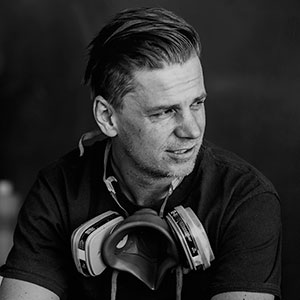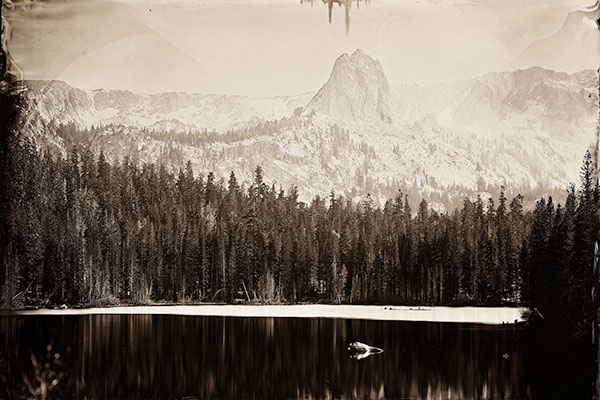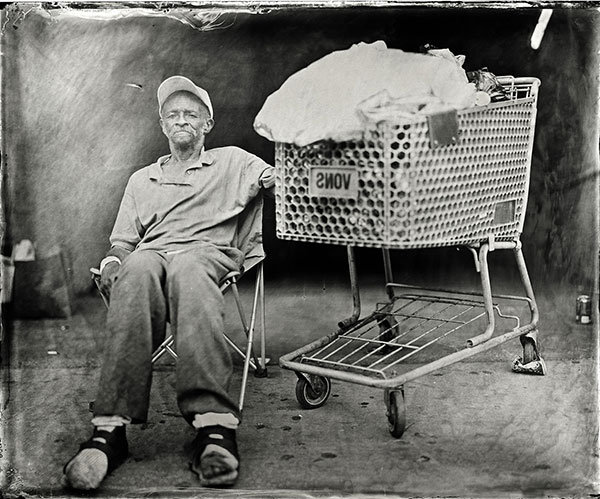
Ian Ruhters’ response to the digital era embraces the past by working in a contemporary manner with a 19th-century photographic process called wet plate collodion

IAN RUHTER |Wet Plate Collodion| Lake Mary Mammoth, Ca 2012
Ian produces one-of-a-kind handmade photographs called Ambrotypes and Tintypes. Working from 19th-century literature he was able to make his own film using USP collodion, silver nitrate, iodides and bromides to produce what he considers to be the most beautiful film in the world. The way the silver halides reflect light creates a three-dimensional viewing experience, unlike any other photographic medium.
In the process, Ian also questions what it means to create an original image. The advent of the photographic negative in the mid-1800s replaced what had been a one-of-a-kind object with secondary object prints from the negative that could be enlarged and mass-produced, making photography a commercial application. The idea of the original was lost. This shift also rendered wet plate collodion obsolete. Now, in the digital era, analogue photography is being replaced by code. Because digital images can be manipulated so easily, we also often find ourselves questioning what is real.
Based on this perspective Ruhter engineered the world’s largest wet plate collodion camera out of a delivery truck and a giant camera lens. The back of the truck served as the body of the camera and mobile darkroom required to make wet plates in the field. After facing years of setbacks with the internal function of the camera he realized that the answer had been with him the entire time. Due to the sheer size of the camera, it would allow for him to work inside the apparatus where it would become a combination of human and machine working simultaneously together. Incorporating this human element allows degrees of imperfections, ensuring that no two captured images are alike.
Rendered impossible to this point, Ruhter’s collection of Tintypes and Ambrotypes ranging in size from 24″ x 30″ to 48″ x 60″ are unlike anything that has existed in photography. Over the past 12 years, this giant camera has served as the vehicle guiding him to make wet plates across the globe. This unique camera allows Ruhter to create a body of work that illustrates Mother Nature and juxtaposes man’s impact on it. Within this observation, he realizes that these impacts on the environment also affect the quality of life of the people who inhabit it.

IAN RUHTER |Wet Plate Collodion| Skid Row Los Angeles, Ca 2010
This led Ruhter to a forgotten town on the edge of the Salton Sea located in California’s Imperial Valley. The idea was to create a camera out of an abandoned house. The structure would serve as the framework for the camera. Instead of focusing on the decay from the outside, this house camera allowed a view from the inside into someone’s dream. Once the giant lens was placed on the front of the house, images of Ted, a 100-year-old resident who recently found himself homeless, were projected in, breathing new life into this abandoned structure and once again making it a home. During this brief moment in time when Teds’ photograph was captured, he was present in both places. In reality, he was homeless in the outside world. However, the projected image simultaneously allowed him to be sitting in the living room where he was once again home. When viewing the life-sized plate it serves as a mirror, allowing one to reflect upon where they will be in the twilight of their life.
Ten seconds of this dream were recorded on a 200-pound sheet of glass coated with collodion. The result was a 66″ x 90″ Ambrotype, which is recognized as the world’s largest wet plate collodion image.
Ruhter’s latest large-scale project explores new uses of the wet plate collodion photography process. After a decade of experimenting, he saw that each of the physical properties used in the process; glass, light and chemistry, were beautiful in their own right. Working with these elements in combination with their relationship to shadow and space were used to create light-sensitive sculptures. This is his introduction to working with multi-dimensional works of art.
Ian Ruhter has been accredited for his contemporary use of analogue photographic processes. His subject is the future allowing him to explore what can photography can be.
His works have been exhibited at the Danziger Gallery New York, Nevada Museum of Art, Fort Wayne Museum of Art, Fahey Klein Gallery Los Angeles, Color Field Project curated by Paul Slack San Francisco, Danziger Gallery Los Angeles, Bombay Beach Biennial Dead Sea Scrolls, Photo London, Pulse Miami, Photo Shanghai, AIPAD New York, Selects Works are in permanent collections of actors Angelina Jolie, Gary Oldman, Paul Sack photographic trust SFMOMA, Sheryl Sandberg COO Facebook, Stuart Butterfield founder Flickr & Slack. Will and Carrie Singleton. In addition, he has been commissioned for large scale projects by H.E. Sheikh Sultan bin Ahmed Al Qasimi UAE, Angelina Jolie, Will & Cary Singleton.
His revolutionary process has led to Interviews by the New York Times – when a photographer is his own camera. CNN news- travel Joshua tree, National Geographic – what is old is new, Travel Channel – America the beautiful narrated by Robert Redford. San Francisco chronicle – perfect imperfections, NPR – Capital public radio. and PBS – Colors.
Keynote speaking engagements are Ted Talk – What would you be willing to sacrifice, Nevada Museum of Art – art & the future of creativity, PDN photo plus, NY, PPOC Vancouver BC, Palm Springs Museum of Art – Silver & Light, Xposure, UAE, Worlds largest Ambrotype.